Related Research Articles
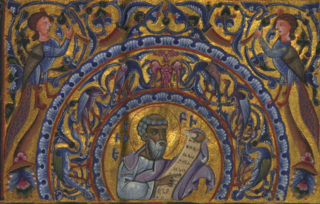
Eusebius of Caesarea, also known as Eusebius Pamphilus, was a Greek historian of Christianity, exegete, and Christian polemicist. In about AD 314 he became the bishop of Caesarea Maritima in the Roman province of Syria Palaestina. Together with Pamphilus, he was a scholar of the biblical canon and is regarded as one of the most learned Christians during late antiquity. He wrote Demonstrations of the Gospel, Preparations for the Gospel and On Discrepancies between the Gospels, studies of the biblical text. As "Father of Church History", he produced the Ecclesiastical History, On the Life of Pamphilus, the Chronicle and On the Martyrs. He also produced a biographical work on Constantine the Great, the first Christian Roman emperor, who was augustus between AD 306 and AD 337.
The First Council of Nicaea was a council of Christian bishops convened in the Bithynian city of Nicaea by the Roman Emperor Constantine I in AD 325.
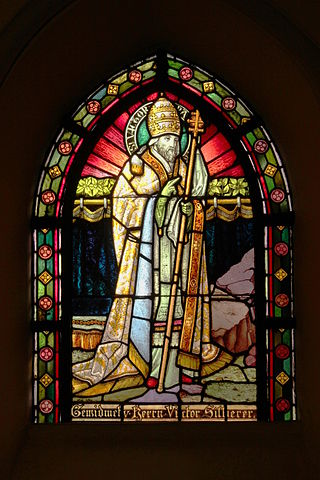
Pope Victor I was the bishop of Rome in the late second century. The dates of his tenure are uncertain, but one source states he became pope in 189 and gives the year of his death as 199. He was born in the Roman Province of Africa—probably in Leptis Magna. He was later considered a saint. His feast day was celebrated on 28 July as "St Victor I, Pope and Martyr".
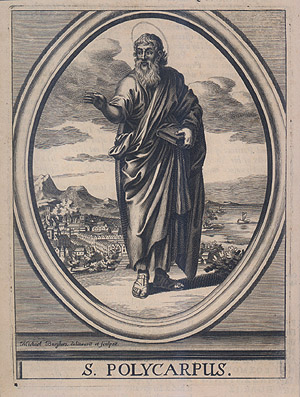
Polycarp was a Christian bishop of Smyrna. According to the Martyrdom of Polycarp, he died a martyr, bound and burned at the stake, then stabbed when the fire failed to consume his body. Polycarp is regarded as a saint and Church Father in the Catholic, Eastern Orthodox, Oriental Orthodox, Anglican, and Lutheran churches.
An apostolic see is an episcopal see whose foundation is attributed to one or more of the apostles of Jesus or to one of their close associates. In Catholicism the phrase, preceded by the definite article and usually capitalized, refers to the See of Rome.
Quartodecimanism is the name given to the practice of celebrating the death of Christ on the day of Passover on the 14th of Nisan according to the biblical dating, being on whatever day of the week. The Quartodeciman controversy in the Church was over the question of celebrating Easter on the first day of the week, Sunday, or at the same time as the sacrifice of the Passover lamb.
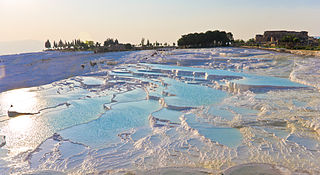
Pamukkale, meaning "cotton castle" in Turkish, is a natural site in Denizli Province in southwestern Turkey. The area is famous for a carbonate mineral left by the flowing of thermal spring water. It is located in Turkey's Inner Aegean region, in the River Menderes valley, which has a temperate climate for most of the year.
Melitius or Meletius was bishop of Lycopolis in Egypt. He is known mainly as the founder and namesake of the Melitians, one of several schismatic sects in early church history which were concerned about the ease with which lapsed Christians reentered the Church.

During the reign of the Roman Emperor Constantine the Great (AD 306–337), Christianity began to transition to the dominant religion of the Roman Empire. Historians remain uncertain about Constantine's reasons for favoring Christianity, and theologians and historians have often argued about which form of early Christianity he subscribed to. There is no consensus among scholars as to whether he adopted his mother Helena's Christianity in his youth, or, as claimed by Eusebius of Caesarea, encouraged her to convert to the faith he had adopted.
The Audians or Anthropomorphites were a sect of Christians in the fourth century in Syria and Scythia, named after their founder Audius, who took literally the text of Genesis, i, 27 — that God created mankind in his own image.
Ammonius of Alexandria is assumed to be a Christian philosopher who lived in the 3rd century. He is possibly Ammonius Saccas, the Neoplatonist philosopher, also from Alexandria.
The controversy over the correct date for Easter began in Early Christianity as early as the 2nd century AD. Discussion and disagreement over the best method of computing the date of Easter Sunday has been ongoing ever since and remains unresolved. Different Christian denominations continue to celebrate Easter on different dates, with Eastern and Western Christian churches being a notable example.
Domnica was the wife of Roman emperor Valens. Valens, who ruled from 364 to 378, was emperor of the East and co-emperor with his brother Valentinian I. After the death of her husband in 378 she ruled as de facto regent and defended Constantinople against the attacking Goths until his successor, Theodosius I arrived.

The East–West Schism that occurred in 1054 represents one of the most significant events in the history of Christianity. It includes various events and processes that led to the schism and also those events and processes that occurred as a result of the schism. Eastern and Western Christians had a history of differences and disagreements, some dating back to the period of Early Christianity. At the very root of what later became the Great Schism were several questions of pneumatology and ecclesiology. The most important theological difference occurred over various questions regarding the procession of the Holy Spirit, and the use of the filioque clause in the Nicene Creed. One of the main ecclesiological issues was the question of papal supremacy. Other points of difference were related to various liturgical, ritual, and disciplinary customs and practices. Some political and cultural processes also contributed to the breakout of the schism.
Saint Thraseas was a martyr under the reign of Emperor Marcus Aurelius. Prior to his death he served as Bishop of Eumenia, Phrygia, in Asia Minor.
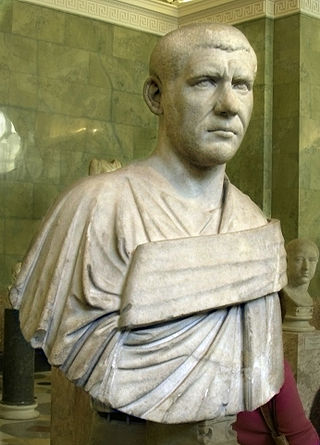
Philip the Arab was one of the few 3rd-century Roman emperors sympathetic to Christians, although his relationship with Christianity is obscure and controversial. Philip was born in Auranitis, an Arab district east of the Sea of Galilee. The urban and Hellenized centers of the region were Christianized in the early years of the 3rd century via major Christian centers at Bosra and Edessa, but there is little evidence of Christian presence in the small villages of the region in this period, such as Philip's birthplace at Philippopolis. Philip served as praetorian prefect, commander of the Praetorian Guard, from 242; he was made emperor in 244. In 249, after a brief civil war, he was killed at the hands of his successor, Decius.

Christianity became the official religion of the Roman Empire when Emperor Theodosius I issued the Edict of Thessalonica in 380, which recognized the catholic orthodoxy of Nicene Christians in the Great Church as the Roman Empire's state religion. Most historians refer to the Nicene church associated with emperors in a variety of ways: as the catholic church, the orthodox church, the imperial church, the imperial Roman church, or the Byzantine church, although some of those terms are also used for wider communions extending outside the Roman Empire. The Eastern Orthodox Church, Oriental Orthodoxy, and the Catholic Church all claim to stand in continuity from the Nicene church to which Theodosius granted recognition.
Dolichianus of Jerusalem was Bishop of Jerusalem in early Christianity. He served during the rule of Commodus about 180AD.
Florinus was a 2nd-century Roman presbyter, however later lost his office after teaching "heretical" doctrines, as he converted to Gnosticism or started to believe some Gnostic views in his later life. Florinus was mentioned by Irenaeus, and was apparently slightly older than him. Just like Irenaeus, Florinus was perhaps once a disciple of Polycarp, but he was later influenced by Valentinians. Eusebius claimed that Florinus taught dualism and that God is the author of evil, though most scholars accept Eusebius' statement, some scholars have suggested that Eusebius was mistaken on Florinus' view of dualism, Florinus also taught Monarchianism. Irenaeus wrote a work against Florinus and he was later excommunicated, likely by Pope Victor I.
Miltiades was a 2nd-century Christian, who wrote three treatises, "against the Greeks", "against the Jews" and an "Apology". He likely started writing before the death of Marcus Aurelius. Miltiades might have been associated with Montanism, however there is confusion on if he was a Montanist, this is because In Eusebius' writings, there appears to be confusion over the name "Miltiades" and "Alcibiades", either due to an error from copyists or from Eusebius himself. It is even possible that he might have written against Montanism.
References
- ↑ Trevett, Christine (2002-07-18). Montanism: Gender, Authority and the New Prophecy. Cambridge University Press. ISBN 978-0-521-52870-2.
- ↑ Gerlach, Karl (1998). The Antenicene Pascha: A Rhetorical History. Peeters Publishers. ISBN 978-90-429-0570-2.
- ↑ Brent, Revd Allen (2015-12-22). Hippolytus and the Roman Church in the Third Century: Communities in Tension before the Emergence of a Monarch-Bishop. BRILL. ISBN 978-90-04-31298-2.
- ↑ Schaff, Philip (2015-03-24). The Christian Church from the 1st to the 20th Century. Delmarva Publications, Inc.
- ↑ Schaff, Philip; Wace, Henry (1890). A Select Library of Nicene and Post-Nicene Fathers of the Christian Church, Second Series. Parker.
- 1 2 NPNF2-01. Eusebius Pamphilius: Church History, Life of Constantine, Oration in Praise of Constantine. CCEL. ISBN 978-1-61025-062-7.
- ↑ "Philip Schaff: NPNF2-01. Eusebius Pamphilius: Church History, Life of Constantine, Oration in Praise of Constantine - Christian Classics Ethereal Library". www.ccel.org. Retrieved 2022-07-01.